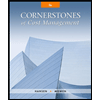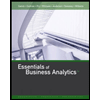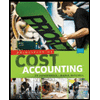
Concept introduction:
Cycle efficiency:
Cycle efficiency denotes about the use of cycle time in value-added activities. In other words, we can say that cycle efficiency shows relationship between value-added time and cycle time. On the basis of cycle efficiency we know about the use of whole cycle time in the value-added activities.
Requirement 1:
Non-value-added time under the traditional manufacturing process.
Answer to Problem 3P
Non-value-added time = 4 + 6 + 2= 12 hours
Explanation of Solution
Non-value-added time = Inspection time + Move time + Wait timeInspection time = 2 hoursMove time = 6 hoursWait time = 2 hoursNow, let's put the values in above given formula;Non-value-added time = 4 + 6 + 2= 12 hours
Concept introduction:
Cycle efficiency:
Cycle efficiency denotes about the use of cycle time in value-added activities. In other words, we can say that cycle efficiency shows relationship between value-added time and cycle time. On the basis of cycle efficiency, we know about the use of whole cycle time in the value-added activities.
Requirement 2:
Cycle efficiency under the traditional manufacturing process.
Answer to Problem 3P
Cycle efficiency = 2436= 0.67
Explanation of Solution
Cycle efficiency = Value-added timeCycle timeValue-added time = Process time Hence, value-added time = 24 hoursCycle time = Process time + Inspection time + Move time + Wait timeCycle time = 24 + 4 + 6 + 2 = 36 hoursNow, let's put the values in above given formula;Cycle efficiency = 2436= 0.67
Concept introduction:
Cycle efficiency:
Cycle efficiency denotes about the use of cycle time in value-added activities. In other words, we can say that cycle efficiency shows relationship between value-added time and cycle time. On the basis of cycle efficiency, we know about the use of whole cycle time in the value-added activities.
Requirement 3:
Non-value-added time under the proposed lean manufacturing process.
Answer to Problem 3P
Non-value-added time = 4 + 3 + 1= 8 hours
Explanation of Solution
Non-value-added time = Inspection time + Move time + Wait timeInspection time = 4 hoursMove time = 3 hoursWait time = 1 hoursNow, let's put the values in above given formula;Non-value-added time = 4 + 3 + 1= 8 hours
Concept introduction:
Cycle efficiency:
Cycle efficiency denotes about the use of cycle time in value-added activities. In other words, we can say that cycle efficiency shows relationship between value-added time and cycle time. On the basis of cycle efficiency, we know about the use of whole cycle time in the value-added activities.
Requirement 4:
Cycle efficiency under the proposed lean manufacturing process.
Answer to Problem 3P
Cycle efficiency = 2432= 0.75
Explanation of Solution
Cycle efficiency = Value-added timeCycle timeValue-added time = Process time Hence, value-added time = 24 hoursCycle time = Process time + Inspection time + Move time + Wait timeCycle time = 24 + 4 + 3 + 1 = 32 hoursNow, let's put the values in above given formula;Cycle efficiency = 2432= 0.75
Concept introduction:
Cycle efficiency:
Cycle efficiency denotes about the use of cycle time in value-added activities. In other words, we can say that cycle efficiency shows relationship between value-added time and cycle time. On the basis of cycle efficiency we know about the use of whole cycle time in the value-added activities.
Requirement 5:
Would the proposed lean approach improve cycle efficiency?
Answer to Problem 3P
Yes, the proposed lean approach would improve cycle efficiency.
Explanation of Solution
Cycle efficiency under the traditional manufacturing process = 2436= 0.67Cycle efficiency under the proposed lean manufacturing process = 2432= 0.75Thus, it is clear that the proposed lean approach would improve cycle efficiency because cycle efficiency is higher under proposed lean approach.
Want to see more full solutions like this?
Chapter C Solutions
Managerial Accounting - Connect Access
- What is the cost of unused capacity?arrow_forwardA $100,000 5-year 6% bond is issued on January 1, 2026. The bond pays interest annually. The market rate is 7%. What is the selling price of the bonds, rounded to the nearest dollar? Question 6 options: $104,213 $95,900 $100,000 $4,100arrow_forwardA $100,000 5-year 6% bond is issued on January 1, 2026. The bond pays interest annually. The market rate is 7%. What is the selling price of the bonds, rounded to the nearest dollar? Question 6 options: $104,213 $95,900 $100,000 $4,100arrow_forward
- Dell Industries has a normal capacity of 30,000 direct labor hours. The company's variable costs are $45,000, and its fixed costs are $27,000 when operating at normal capacity. What is its standard manufacturing overhead rate per unit?arrow_forwardWhich statement about a "treasury shares" is correct? Question 10 options: These shares continue to have voting rights. These shares must be cancelled upon re-purchase. The company does not pay dividends on these shares. These shares are disclosed as issued and outstanding.arrow_forwardWhich statement best describes the accounting when a company cancels its own shares at an amount higher than the average share value? Question 9 options: Contributed surplus and retained earnings will be debited. Contributed surplus will be debited, thereby decreasing equity. Contributed surplus and retained earnings will be credited. Contributed surplus will be credited, thereby increasing equity.arrow_forward
- Which statement is correct? Question 8 options: A corporation need only pay dividends when it declares them to be payable. A company can avoid a cumulative dividend on preferred shares if it declares dividends on common shares. Dividends are never discretionary payments. Companies must pay the shareholders interest to compensate for the time value of money lost on the deferral of dividend payments. No entryarrow_forwardWhich statement is correct about the derecognition of a matured obligation? Question 7 options: There will be a gain on retirement. There could be either a gain or loss on retirement. There will be no gain or loss on retirement. There will be a loss on retirement.arrow_forwardWhat is a bond indenture? Question 5 options: Guarantee of the price to the borrower. Promise from the borrower to restrict certain activities. Contract that outlines the terms of the borrowing agreement. Feature that permits the borrower to redeem before maturity.arrow_forward
- Which of the following would be a "non-current liability"? Question 4 options: Payment due to a supplier 45 days after year-end for supplies received before year-end. Payment due to a supplier in 18 months for goods to be received 3 months after year-end. Payment due after 3 years, on which the debt covenants have been not been violated. Payment due after 3 years, but the company has violated the debt covenants. Previous PageNext Pagearrow_forwardWhich statement about contingencies is correct? Question 3 options: If the future outcome is probable and reliably measurable, a provision is recorded. If the future outcome is possible, a provision is recorded even if it is not reliably measurable. If the future outcome is possible and reliably measurable, a provision is recorded. If the future outcome is probable, a provision is recorded even if it is not reliably measurable. Previous PageNext Pagearrow_forwardWhat is the manufacturing overhead?arrow_forward
 Cornerstones of Cost Management (Cornerstones Ser...AccountingISBN:9781305970663Author:Don R. Hansen, Maryanne M. MowenPublisher:Cengage Learning
Cornerstones of Cost Management (Cornerstones Ser...AccountingISBN:9781305970663Author:Don R. Hansen, Maryanne M. MowenPublisher:Cengage Learning Managerial Accounting: The Cornerstone of Busines...AccountingISBN:9781337115773Author:Maryanne M. Mowen, Don R. Hansen, Dan L. HeitgerPublisher:Cengage Learning
Managerial Accounting: The Cornerstone of Busines...AccountingISBN:9781337115773Author:Maryanne M. Mowen, Don R. Hansen, Dan L. HeitgerPublisher:Cengage Learning Excel Applications for Accounting PrinciplesAccountingISBN:9781111581565Author:Gaylord N. SmithPublisher:Cengage Learning
Excel Applications for Accounting PrinciplesAccountingISBN:9781111581565Author:Gaylord N. SmithPublisher:Cengage Learning Managerial AccountingAccountingISBN:9781337912020Author:Carl Warren, Ph.d. Cma William B. TaylerPublisher:South-Western College Pub
Managerial AccountingAccountingISBN:9781337912020Author:Carl Warren, Ph.d. Cma William B. TaylerPublisher:South-Western College Pub Essentials of Business Analytics (MindTap Course ...StatisticsISBN:9781305627734Author:Jeffrey D. Camm, James J. Cochran, Michael J. Fry, Jeffrey W. Ohlmann, David R. AndersonPublisher:Cengage Learning
Essentials of Business Analytics (MindTap Course ...StatisticsISBN:9781305627734Author:Jeffrey D. Camm, James J. Cochran, Michael J. Fry, Jeffrey W. Ohlmann, David R. AndersonPublisher:Cengage Learning Principles of Cost AccountingAccountingISBN:9781305087408Author:Edward J. Vanderbeck, Maria R. MitchellPublisher:Cengage Learning
Principles of Cost AccountingAccountingISBN:9781305087408Author:Edward J. Vanderbeck, Maria R. MitchellPublisher:Cengage Learning





